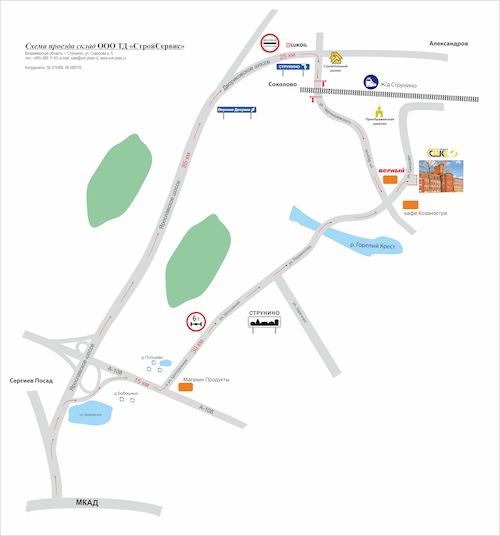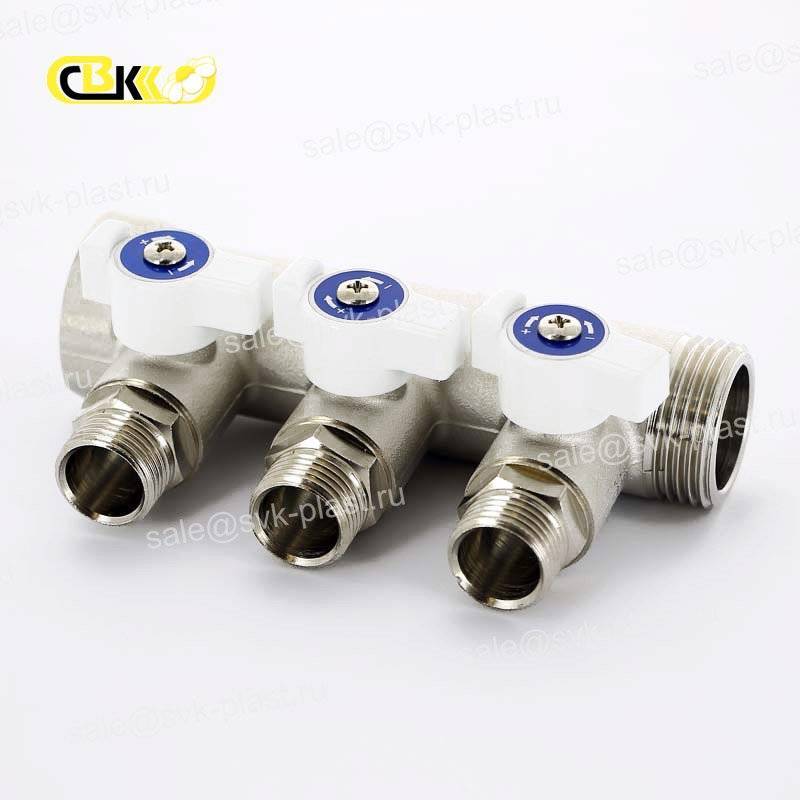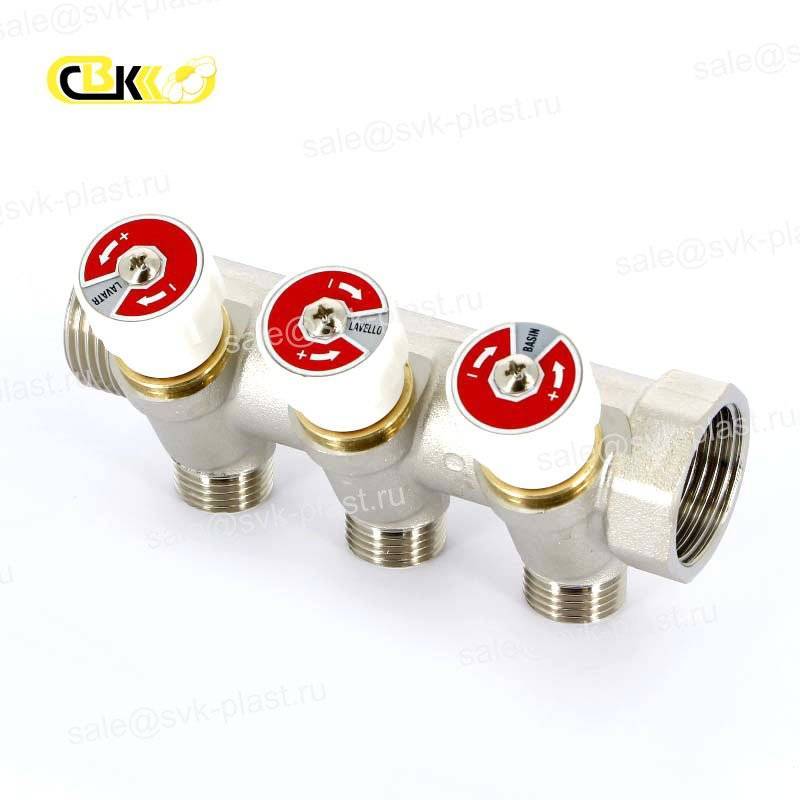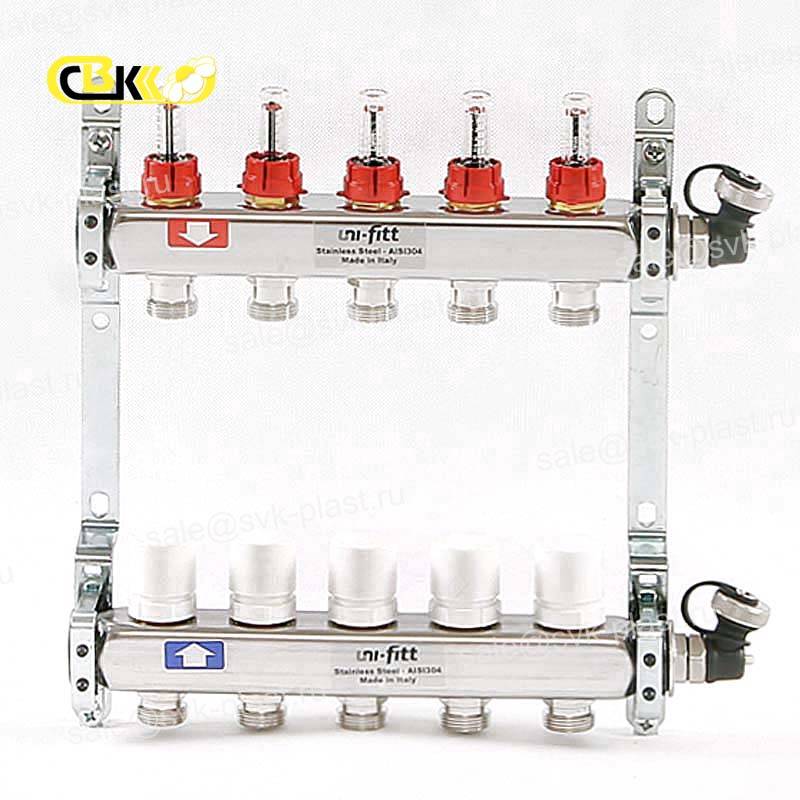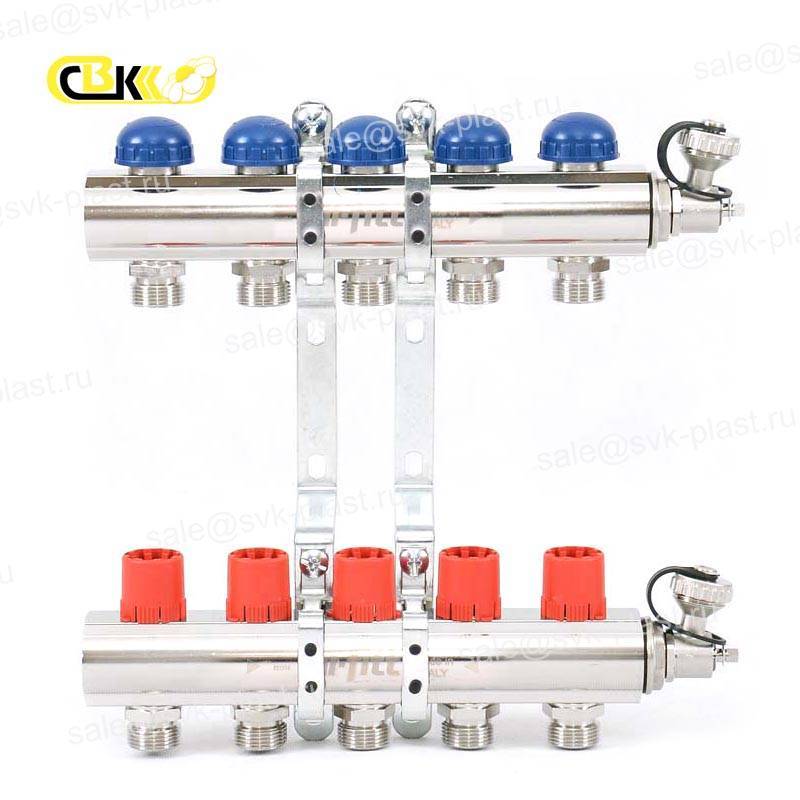Uni-FITT collectors
UF HP Collector/BP with ball valves
| Vendor code | Name |
|---|---|
| 31808N050403 | UF HP Collector/BP 3/4" 3 x 1/2 " H 40 mm with taps Nickel-plated |
| 31808N060403 | UF HP Collector/BP 1 "3 x 1/2" H 40 mm with taps Nickel-plated |
| 31808N060402 | UF HP Collector/BP 1" 2 x 1/2 " H 40 mm with taps Nickel-plated |
| 31808N050404 | UF HP Collector/BP 3/4" 4 x 1/2 " H 40 mm with taps Nickel-plated |
| 31808N050402 | UF HP Collector/BP 3/4" 2 x 1/2 " H 40 mm with taps Nickel-plated |
UF HP Collector/BP with valves
| Vendor code | Name |
|---|---|
| 31108N050402 | UF HP Collector/BP 3/4" 2 x 1/2 " H 40 mm Nickel-plated with valves |
| 31108N050404 | UF HP Collector/BP 3/4" 4 x 1/2 " H 40 mm Nickel-plated with valves |
| 31108N050403 | UF HP Collector/BP 3/4" 3 x 1/2 " H 40 mm Nickel-plated with valves |
| 31108N060404 | UF HP Collector/BP 1 "4 x 1/2" H 40 mm Nickel-plated with valves |
| 31108N060402 | UF HP Collector/BP 1" 2 x 1/2 " H 40 mm Nickel-plated with valves |
| 31108N060403 | UF HP Collector/BP 1" 3 x 1/2 " H 40 mm Nickel-plated with valves |
UF collector group with flow meters and thermostatic valves, brass
UF collector group with flow meters and thermostatic valves, stainless steel.steel
UF Call group with control and thermostatic valves, brass
| Vendor code | Name |
|---|---|
| 32315N060502 | UF Call group 1'x3/4 ' 2 with control and thermostatic valves |
| 32315N060503 | UF Call group 1'x3/4 ' 3 with control and thermostatic valves |
| 32315N060504 | UF Call group 1'x3/4 ' 4 with control and thermostatic valves |
| 32315N060505 | UF Call group 1'x3/4 ' 5 ' with control and thermostatic valves |
| 32315N060506 | UF Call group 1'x3/4 ' 6 with control and thermostatic valves |
| 32315N060507 | UF Call group 1'x3/4 ' 7 with control and thermostatic valves |
| 32315N060508 | UF Call group 1'x3/4 ' 8 with control and thermostatic valves |
| 32315N060509 | UF Call group 1'x3/4 ' 9 with control and thermostatic valves |
| 32315N060510 | UF Call group 1'x3/4 ' 10 with control and thermostatic valves |
| 32315N060511 | UF Call group 1'x3/4 ' 11 with control and thermostatic valves |
| 32315N060512 | UF Call group 1'x3/4 ' 12 ' with control and thermostatic valves |
UF collector group with control and thermostatic valves stainless steel.steel
Collector with flow meters for the "Underfloor heating" system»
Currently, many apartment owners prefer to install modern heating systems, and the most popular of them is a warm water floor. The use of heat given off by a liquid heat carrier allows you to achieve the highest efficiency when heating residential premises. Even a superficial analysis of the design scheme of the heating system allows you to understand that this method of heating will be optimal. The water floor works completely differently from the usual radiators and other solutions. In such conditions, the performance of all components, devices and devices connected to a common heating circuit is important.
The efficiency of the heating system operation is largely determined by the specifics of the coolant consumption in the pipes. In this case, special collectors for Underfloor heating can help, which together with flow meters guarantee the correct distribution of hot water in the heating circuits. How does the "collector + flow meter" combination look and work, and what are the distinctive features of its functionality? Let's look at these questions in more detail.
Purpose of the collector with flow meters
The main difference between Underfloor heating as a heating system is that the heated coolant, circulating through the heating circuit, gives the floor part of the heat. As a result, due to the heating of the floor covering, heat is transferred and the heat passes into the air, which continuously moves inside the room. In this case, the heated air rises, and the cold air falls. Several devices are responsible for supplying hot coolant to the heating system circuits, as well as regulating the pressure and speed of the coolant, including:
- three-way valve;
- collector;
- circulation pump.
A special flow meter designed for Underfloor heating controls the distribution of the liquid coolant. This device is extremely important for the functioning of the pump-mixing bundle as a whole. Specialized collectors allow you to feed the heated coolant and collect the waste liquid for its subsequent use in the pipeline. In the pump-mixing group, the heated heat carrier coming from the boiler room is mixed with the waste liquid being sent to the return circuit. This principle of operation made it possible to make a warm floor a full-fledged and highly efficient way to heat rooms.
In addition to monitoring the operation of valve fuses, rotameters allow you to adjust the temperature of the liquid in the heating system circuits. The presence of such devices allows you to maintain the desired level of heated coolant entering the heating circuit. In essence, this device controls the volume of hot water in the Underfloor heating pipes, and thus the performance of the heating system as a whole.
The operation of the flowmeter
A rotameter, also called a float rotameter, is a technological unit that is, in fact, an ordinary mechanical device. The main design element of the device is a plastic case (there are also brass models on the market), in the inner part of which there is a float made of polypropylene. The case itself is equipped with a transparent cone with marked scale divisions. A float that moves vertically inside the device always indicates a certain division of the scale, which is used to find out how much hot water is currently flowing in the heating system, and whether it is enough for the normal functioning of the heating circuits.
Theoretically, the heating system is quite capable of fully functioning even in the absence of such a device. However, in such a situation, you will need to independently regulate the amount of coolant flowing into the circuit, based on your own preferences regarding the temperature level in the house.
Attention! Based on the sound produced by the pump turned on and the degree of heating of the Underfloor heating, you can find out how effectively the heated coolant is distributed along the heating circuits.
If you refuse to install a flow meter when arranging water floors in the future, you may encounter a number of problems, for example:
- some floor heating circuits will receive hot water without taking into account the specifics of a particular room, as a result of which the temperature indicators in the heated rooms will differ;
- energy consumption will increase significantly regardless of what type of energy carrier is used for heating (electricity or gas).
Let's say you are going to heat the children's room and bathroom in parallel. Then the gas boiler with Autonomous connection will equally warm up the heat carrier intended for both rooms, without changing the temperature regime. But given that the size of the bathroom is smaller, you will not need as much heated water from the boiler to warm it up as in the nursery. The presence of a flow meter will allow you to achieve the necessary temperature indicators by regulating the volume of the supplied coolant in the rooms. Thus, this device is designed for temperature control in different rooms.
Evaluation of the specifics of the operation and principle of operation of this device shows that:
- the device operates independently, so it does not need additional power sources;
- the flow meter makes it possible to achieve a rational consumption of heat carrier in heating circuits, significantly reducing the energy consumption of heating devices;
- the device is designed in such a way that at any time it is possible to visually check the level of filling of pipes with coolant;
- the joint operation of the collector and flow meters greatly simplifies the supervision of the system as a whole, and these devices are easy to install and do not require complex maintenance.
Attention! The device is installed vertically, just screw it into the appropriate socket of the collector. A cap nut is used to secure the device.
On a note: when installing a water floor, try to achieve an equal length of the heating ducts of the heating circuits. Despite the possible differences in configuration, such a solution will greatly facilitate the regulation of the heating system and make it possible to set a comfortable temperature in the premises.
Operating principle, installation and configuration of the flow meter
When installing the collector and connecting the heating circuits of the heating system, the flow meter is mounted on a collecting comb, to which the spent heat carrier is redirected. If the temperature of the liquid reaches the set value, a valve is triggered in the collector, aimed at narrowing or completely blocking the opening for incoming water. In order for the system to function according to this principle, the pump and mixing group and the collector are equipped with thermostats.
To achieve the matching of the coolant level in a transparent flask with the horizontal scale divisions, the device must stand strictly vertically. Therefore, for the correct functioning of the control unit, it is necessary to mount the collector using a plumb line or a bubble level in order to achieve a strict horizontal arrangement of all equipment components. Installation of the collector with deviations from the horizontal can lead to incorrect operation of the heating system.
Attention! Finishing work in the rooms and installation of the collector Cabinet can damage some components of the mixing unit. for this reason, it is necessary to observe the principle of compactness when placing the heating system equipment.
Install and configure the equipment in accordance with the attached instructions, if possible, following the following sequence of actions:
- using a wrench, screw the flow meter into a special hole in the manifold;
- prepare the device for switching on by turning the flask counterclockwise;
- remove the factory fuse (usually ring-shaped);
- set the required pressure level by turning the brass ring located in the housing clockwise to the desired mark – the position of the float will indicate the adjustment made;
- to protect the device from damage, cover the brass ring with the appropriate pad;
- test the device by turning on the heating system.
Conclusion
Make sure that the flow meter bulb is always available for inspection and, if necessary, for maintenance during the operation of the system.
Please note that flow meters must be installed on all heating circuits connected to the collector.
The heating efficiency and efficiency of the heating system practically do not depend on the flow meter model. To get high performance, it is enough to follow the instructions for installation and operation of the equipment.



